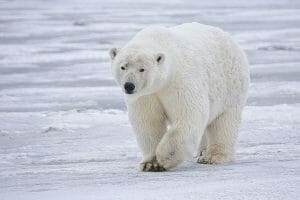The structure of the energy or food pyramid in the tundra varies depending on its exact location. An example is the generalized terrestrial food pyramid of the arctic tundra. Occupying the base of the energy pyramid in this biome are producer organisms such as lichens, mosses, liverworts, algae, wildflowers, shrubs, sedges and grasses that transform carbon dioxide and energy from the sun into carbohydrates and oxygen. The next level of the pyramid is home to primary consumers (herbivores) like pikas, musk oxen, caribou, squirrels, lemmings and artic hares that feed on the producers. Next, brown bears, arctic foxes, arctic wolves and snowy owls occupy the secondary consumer level. These creatures are categorized as carnivores or omnivores. Finally, the polar bear lives at the top of the food pyramid because it has no natural predators. Polar bears also eat seals and fish that live in the water, which shows how this single energy pyramid interconnects to energy sources in other biomes.

The image above shows a polar bear, an animal at the top of the energy pyramid in the arctic tundra.
References
- Beyond Penguins and Polar Bears. Life in the Tundra. (n.d.). Retrieved December 27, 2017 from http://beyondpenguins.ehe.osu.edu/issue/tundra-life-in-the-polar-extremes/life-in-the-tundra
